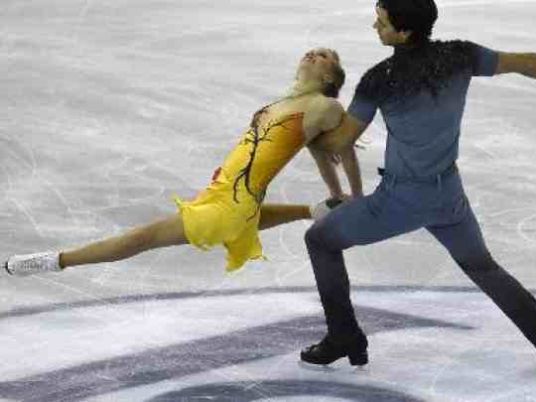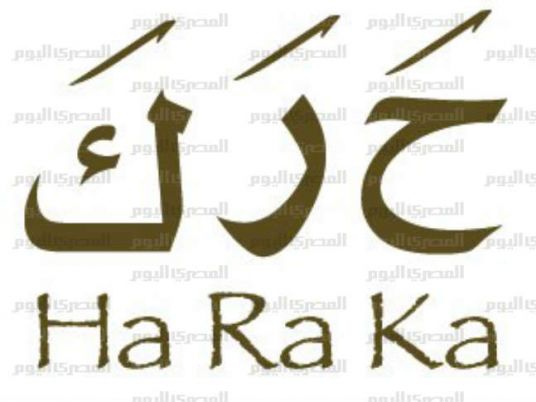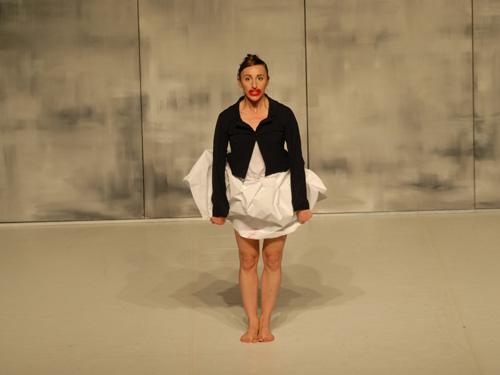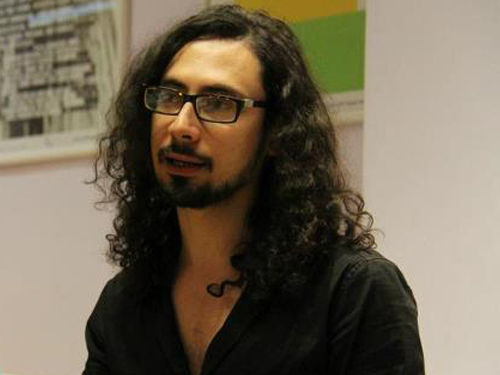Contemporary dance has an intimidating reputation. Those of us with little knowledge of it tend to have fixed ideas of what it looks like, and the images in our minds are often unlikely to attract us to theaters.
The second yearly edition of “Contemporary Dance Night,” which is on at Cairo’s Falaki Theater this week, seeks to change that attitude. It is “a set of dance shows that aim to familiarize and develop the art of contemporary dance in Egypt,” coordinated by dancer and choreographer Ezzat Ezzat, who wants to “widen the circle of audience of contemporary dance.”
Two different sets of shows are being presented on alternate nights. The performances of “Group A” were presented on Saturday night to an initially full house. While the two video works shown had the flat stylishness of music videos, eight live performances offered more depth and a diversity of approaches.
Various elements of contemporary dance offer access points for new audiences; and with varying degrees of playfulness and success, the young performers of “Group A” exploit these elements.
The most obvious appeal or access point is that of bodies in motion, which most people have a natural admiration for, whether for their athleticism or their sensuality or just because of a general curiosity about what other people’s bodies look like. All the dances on Saturday played on this appeal.
“Deeper than It Looks on the Surface” was performed by 15 dancers from the Egyptian Modern Dance Theatre Company, directed and choreographed by Monadel Antar. The dancers’ brightly colored, sporty outfits, their efforts toward mass synchronization and their athletic leaping around spoke of an aerobics workout. The frenetic dancing accelerated as the music increased in volume.
While motion and slinky outfits were its main selling point, the performance also exploited drama and narration, another element utilized by all the evening’s performances, which each relied on text in some way. The apologetically named “Deeper than it Looks” started with dramatic darkness, thunder, and a quote from Hamlet. Episodes of hysterical dialogue scattered throughout the dance gave the impression of a soap-opera style narrative.
A very different sort of narrative, one based on suspense and pathos, was evident in Ahmed Ezz’s “Waiting.” Various props somehow associated with decadence — drinks, a black forest cake, an armchair, a trilby hat — supported the narrative, and made up the most elaborate set and costume that evening. Bodily appeal was also played on here, but archly: Ezz, whose body is chunkier than that of your stereotypical dancer, spends most of the one man-show wearing just underpants, and at once point performs an uncompleted strip-tease.
This is another audience entry point: humor. The audience spent much of Ezz’s dance laughing — it bordered on slapstick at points. Humor and self-reflexivity were also important for “Two Dance Burgers, Please?” by Hazem Header and Matthieu Sparma. It directly confronted the idea — our ideas — of contemporary dance (thinking of it as a “product,” according to the blurb). It brought the seductive or distracting methods used to pull people in to the forefront. Four dancers carried out different tasks — counting, doing push-ups, thinking, dancing on the spot — before changing places and taking on new tasks according to instructions on the flash cards they held. Eventually one dancer, Mona Gamil, stopped and cried, “Excuse me, what are we doing? This is meant to be contemporary dance — they paid money to come and see this?” Three dancers hastily congregated in the center to discuss the problem. “There is a script somewhere,” said one, running off to find it.
Each dancer in “Two Dance Burgers” stood out as technically skilled and distinct characters, in particular the charismatic Nagham Salah Othman. She was the first to walk out on the stage and stare down the audience, and while the others argued about the “script” she swaggered up and down grinning and preening at the audience, making them laugh and clap. When the music stopped, the sound was just of breathing and movement.
Music was hugely important to all the performances, maintaining rhythm, creating mood and injecting references. The apparently video-game inspired fantasy of Mounir Saeed’s “Don’t Make Me Hurt You!” was fueled by generic hard rock played by an onstage drummer and electric guitarist. The idea of an all-male rock band perfectly framed the aggressive but comic boyishness of the dance. “Two Dance Burgers” relied on a wide range of music from Vivaldi to Daft Punk, while emotive music was also used by Ezz, whose solitary performance ended on a comic note with John Lennon’s “Imagine.”
Hanaa Safwat, a visual artist and a performer in Mirette Mechail’s choreography as part of “Group B,” suggested to Egypt Independent that there are two types of performances, with distinct approaches to audience: those that are “doing something close to the people sitting there, and those looking down on people.”
That is a useful way to think about the “Group A” performances — and sums up the opposing approaches of the frenetic, high-volume “Deeper than It Looks” and the more thoughtful and cunning “Two Dance Burgers.” If the aim is to win over the audience, approaching the task with self-aware artfulness rather than volume and histrionics seemed the more successful method on Saturday.
Safwat also said, “One of the great things about contemporary dance [is] you can do any everyday movement and it can convey the same meaning as if it were made on the street.” Again, the dances that used the everyday — which is quite conducive to humor — and spoke directly to the audience were better received than those using bombast to impress them.
Overall, Saturday night was both very good and very bad: a good reason to catch the next shows if possible. While the audience thinned out in the second half, on the next night the auditorium was full up 45 minutes before the free show started. The last night, Tuesday, 11 September, will be followed by three days of workshops open to the public and run by the CDN choreographers. The performances will be also staged in November in Alexandria.
The project gives selected performers a rehearsal space and small production fee, and has succeeded in gaining several local and international sponsors. Significantly, CDN is the first collaborative initiative between several Egyptian dance practitioners and companies since the scene was dominated by choreographer Walid Aouni under the umbrella of the Culture Ministry before the 25 January uprising. That such collaboration is possible suggests that Egypt’s relatively young contemporary dance scene is maturing: scarce resources previously bred an atmosphere of competition.
This seems to be good timing, as the number of people waiting outside the Falaki Theater in vain on Sunday night, hoping to be let in, indicates an increasing appetite for dance in Cairo. They should get a bigger theater next year.
“Contemporary Dance Night 2: We’ve Got More!” Falaki Theater, 8 pm Monday and Tuesday, and at the Bibliotheca Alexandrina from 20-21 November.




